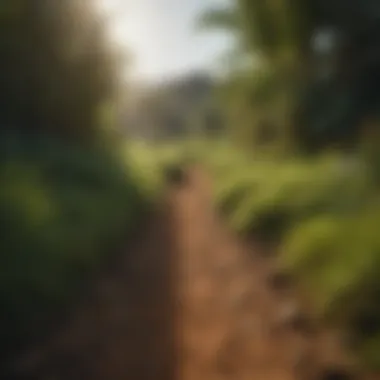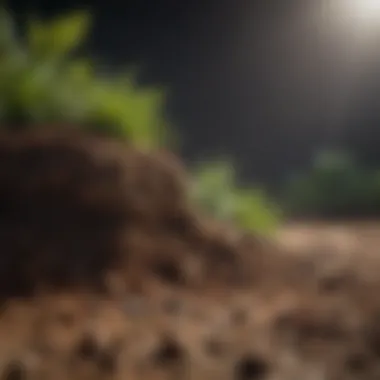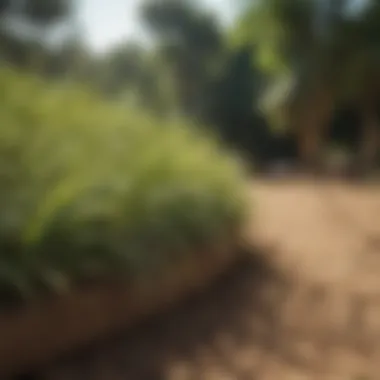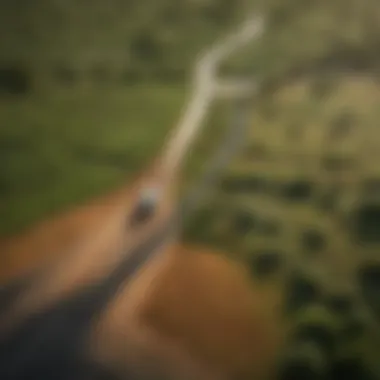Understanding the Cost of Bahia Sod: A Comprehensive Analysis


Intro
Bahia sod, a resilient and versatile grass, plays an essential role in both landscaping and agricultural sectors. Understanding the costs associated with Bahia sod is crucial for those interested in utilizing it for their projects. This analysis aims to unravel the pricing structure surrounding Bahia sod, illuminating various factors that impact its cost.
The focus is not solely on the price per square foot but expands to include regional variations, bulk purchasing strategies, and quality implications.
Topic Overview
Definition of Key Terms
To fully grasp the dynamics of Bahia sod pricing, familiarity with some key terms is necessary. Understanding what Bahia sod is, how it grows, and its unique characteristics can provide insight into its value.
Bahia grass is a warm-season grass native to South America. It is favored for its drought resistance and ability to thrive in poor soil conditions.
Relevance in Agriculture, Horticulture, and Agronomy
Bahia sod's relevance in agriculture lies in its ability to provide a sustainable ground cover. It contributes to soil health, prevents erosion, and supports biodiversity. In horticulture, Bahia sod is used for lawns, parks, and commercial landscapes, offering an aesthetic appeal alongside its functional benefits. Agronomists regard it as a vital component in sustainable farming practices and conservation efforts.
These aspects highlight the importance of a nuanced understanding of Bahia sod pricing, as it directly influences not just aesthetic choices but ecological outcomes as well.
Current Trends and Innovations
Recent Advancements in the Field
The sod industry has witnessed several advancements, leading to innovative practices. New breeding techniques have resulted in improved cultivars of Bahia grass that offer increased drought tolerance and disease resistance. These enhancements directly influence market pricing, as higher-quality seeds often command a premium.
Emerging Technologies and Practices
Technological advancements are also changing how Bahia sod is cultivated and marketed. The use of precision agriculture techniques allows farmers to optimize inputs and maximize yields. Furthermore, digital platforms for purchasing sod are making it easier for consumers to compare prices and quality, reshaping the traditional market interaction.
Practical Applications
Step-by-Step Guides or How-Tos
For those looking to purchase Bahia sod, it is essential to follow a structured approach.
- Assess your needs - Determine the area you plan to cover and the specific conditions, such as sunlight and soil type.
- Research suppliers - Find reputable sources that provide high-quality Bahia sod.
- Compare prices - Consider regional variations in pricing, as these can significantly affect your budget.
- Consider bulk purchases - Often, buying in bulk can lead to cost savings.
- Plan installation - Decide whether to install it yourself or hire professionals.
Tips and Best Practices for Implementation
Using Bahia sod effectively requires attention to detail. Proper soil preparation is critical for successful installation. Ensure the ground is level and free of weeds. Regular maintenance, including watering and mowing, will help maintain its health and appearance. Quality and price are intertwined, so always prioritize sourcing from reputable sources to ensure the best outcomes.
"Understanding the cost structure of Bahia sod is imperative for making informed decisions in landscaping and agricultural applications."
By methodically examining these elements, you can navigate the Bahia sod market with increased confidence.
Prelude to Bahia Sod Pricing
Understanding the pricing of Bahia sod is critical for anyone involved in landscaping or agricultural practices. Bahia sod is a perennial grass that serves as a popular choice for both residential lawns and agricultural applications. As with any product, knowing the pricing structure helps customers make informed decisions and effectively manage their budgets. This section emphasizes the importance of understanding Bahia sod pricing, focusing on its implications not just for cost management but also for achieving desirable outcomes in landscaping and agriculture.
Definition of Bahia Sod
Bahia sod, scientifically known as Paspalum notatum, is a warm-season grass highly regarded for its durability and adaptability. It thrives in a range of soil types and climatic conditions, making it a favored choice in many regions, particularly in the southeastern United States. Common uses of Bahia sod include lawns, sports fields, and erosion control in agricultural settings. Its robust root system allows it to withstand drought and recover quickly from stress, contributing to its popularity among farmers and homeowners alike.
Importance of Pricing Information
Acquiring accurate pricing information for Bahia sod is essential for multiple reasons:
- Budget Management: Understanding costs allows individuals and organizations to allocate funds appropriately for their sod needs.
- Informed Purchasing Decisions: Knowledge of pricing helps buyers evaluate different suppliers and options, ensuring they receive the best value.
- Quality Assessment: Pricing often reflects the quality of the sod; hence, discerning quality from cost can facilitate better long-term choices.
As a key component of landscaping and agricultural projects, Bahia sod pricing must be considered carefully. Without this understanding, customers risk overspending or selecting lower-quality sod that may not meet their project needs. Thus, grasping the nuances of Bahia sod pricing plays a vital role in the overall success of landscaping endeavors.


Factors Influencing Bahia Sod Prices
Understanding the factors that influence Bahia sod prices is crucial for anyone planning to invest in this type of sod, whether for commercial agriculture or landscaping purposes. By grasping these elements, buyers can navigate the market more effectively and make decisions that align with both their budget and quality requirements. Each factor contributes differently to the overall cost structure, and an analysis sheds light on how these elements interact and impact prices.
Quality of Sod
The quality of Bahia sod plays a significant role in its pricing. High-quality sod tends to be more expensive due to its stronger root systems, better drought resistance, and overall health. Quality is often determined through several assessments, including the thickness of blades, color, and absence of diseases or pests.
It is advantageous for buyers to conduct a physical inspection or request samples whenever possible. Purchasing inferior quality sod might seem economical but can lead to increased maintenance costs and a shorter lifespan. Thus, investing in superior-quality sod is often more cost-effective in the long run.
Source and Production Methods
The source of Bahia sod and the production methods employed significantly impact pricing. Sod produced through sustainable practices may have a higher base price due to the associated labor and resources. Conversely, sod grown in bulk under conventional methods may yield lower prices, but the quality may also vary.
It is prudent to consider the reputation of the supplier and the cultivation process. Factors such as soil quality, climate conditions, and farming techniques come into play. In addition, understanding local agricultural practices can provide insight into expected variations in sod pricing in different regions. Buyers should weigh these considerations when selecting their sod, as the source and methods can reflect both current and future costs.
Seasonal Variations
Seasonal variations significantly affect Bahia sod prices. Demand increases during specific periods, such as spring and early summer when landscaping activities peak. Prices may rise accordingly.
In contrast, purchasing sod during off-peak seasons, like late fall or winter, may yield better deals. The sod’s availability can fluctuate based on seasonal growth cycles, weather conditions, and local market dynamics.
Buyers should be mindful of these seasonal trends. Planning purchases around these patterns can save significant costs. Timing and awareness of the market can lead to advantageous buying decisions.
Price Range of Bahia Sod
Understanding the price range of Bahia sod is crucial for both agricultural farmers and landscaping enthusiasts. The variability in cost can significantly influence budgeting and planning for projects. An informed decision about purchasing transfers to not just the financial cost but also the potential value gained from the sod. This section will delve into three key components: the average cost per pallet, regional pricing differences, and the economies of scale associated with bulk purchases. Each of these factors holds importance when considering Bahia sod for both personal and commercial applications.
Average Cost per Pallet
The average cost of Bahia sod per pallet fluctuates based on several factors. Typically, one pallet covers around 450 square feet. The price can range from $120 to $400, depending on the quality, seller, and regional availability. This initial cost sets the foundation for any landscaping project. Knowing the average is a first step in making the right choice.
Several elements influence this average cost:
- Quality of the sod: Higher quality Bahia sod usually demands a premium price.
- Supplier reputation: Established suppliers may charge more due to their service and guarantees.
- Pricing trends: Market conditions may affect pricing, such as increased demand ldocally or seasonal shifts.
It's advisable to obtain quotes from multiple suppliers before making any commitments. This will not only provide a clearer picture of options available but also help in negotiating a better price.
Regional Pricing Differences
Regional pricing differences for Bahia sod can be quite pronounced. In some areas, such as Florida and southern Georgia, the prices may be lower due to the proximity of suppliers and abundant production. Conversely, regions further from production sources may encounter inflated prices due to transportation costs.
Specifically, consider factors such as:
- Geographic location: Areas close to the sod farms typically see lower transportation fees, impacting total costs.
- Local demand: Regions with higher demand may price the sod higher, as competition among buyers increases.
Awareness of these regional distinctions can help customers choose when and where to buy their sod, potentially saving money in the process.
Economies of Scale in Bulk Purchases
Purchasing Bahia sod in bulk offers several economic advantages. When buying larger quantities, the per-pallet cost typically decreases. Suppliers often provide discounts for bulk orders, incentivizing larger purchases. This can be particularly beneficial for landscapers or farmers planning extensive projects.
Key points to consider include:
- Negotiation opportunities: Bulk purchases open up avenues for negotiating prices with suppliers.
- Reduced transportation costs: Shipping multiple pallets at once can minimize delivery fees.
Ultimately, planning for bulk sod purchases can optimize costs and improve project efficiency.


“Understanding the variability in Bahia sod pricing not only aids in budgeting but also significantly impacts the overall success of landscaping or agricultural endeavors.”
Additional Costs Beyond Purchase
When considering the overall cost of Bahia sod, it is crucial to examine expenses that extend beyond the initial purchase price. These costs can significantly affect the total investment and, in turn, the long-term viability and aesthetics of the landscaping or agricultural endeavor. Understanding these additional expenses allows buyers to budget accordingly and make informed decisions.
Transport and Delivery Fees
Transport and delivery fees can vary widely based on distance from the supplier and the amount of sod being purchased. These fees are often overlooked in the initial budgeting phase. If one buys sod in bulk, such as multiple pallets, the delivery costs per pallet may decrease, presenting an opportunity for savings. However, distant suppliers may charge higher fees, negating those potential savings.
Additionally, buyers should be aware of any potential access fees if the delivery location is challenging to reach, which might include additional charges for navigating narrow streets or areas with limited access.
Installation Expenses
Installation expenses can arise whether one is handling the sod themselves or hiring professionals. If choosing to install the sod independently, it may be necessary to invest in tools or equipment, such as sod cutters, rollers, or even transport vehicles. Moreover, improper installation can lead to issues, so a firm understanding of best practices is vital.
For those hiring professionals, the costs can vary greatly depending on local labor rates. Factors such as the size of the area being sodded and the complexity of the installation will influence overall costs. Ensuring that the installer has experience with Bahia sod specifically is important, as the intricacies of different sod types may require specialized knowledge.
Ongoing Maintenance Costs
Once Bahia sod is installed, ongoing maintenance costs become a reality that should not be underestimated. These expenses include regular watering, fertilization, mowing, and pest control. The specifics of maintenance will depend on the local climate and the sod’s unique needs.
Initially, new sod requires abundant water to establish roots, which could lead to increased water bills for a period. Additionally, fertilizers may be necessary to promote healthy growth. Regular mowing and pest management will require ongoing attention and could require hiring services or purchasing products if done independently.
In summary, understanding additional costs beyond the purchase price of Bahia sod is essential for any agricultural farmer or landscaping enthusiast. By recognizing transport and delivery fees, installation expenses, and ongoing maintenance costs, buyers can ensure a comprehensive financial plan that accommodates all aspects of sod management.
Quality Considerations in Pricing
When purchasing Bahia sod, the quality is a significant factor that influences not just the initial price but also long-term costs and satisfaction. High-quality sod can result in better growth, durability, and overall health of the lawn or landscape. To make an informed decision, it is essential to understand how to identify quality sod and what benefits arise from choosing higher quality.
Identifying High-Quality Bahia Sod
Several characteristics define high-quality Bahia sod, and recognizing these traits will guide buyers towards making smarter choices. Here are key points to consider:
- Color and Texture: Premium Bahia sod typically exhibits a rich green hue, indicative of health and vitality. The texture should be dense and firm, without excessive thatch.
- Root System: A strong root system is vital for successful establishment. When inspecting sod, look for visible roots at the edges of the pieces. Well-established roots indicate a healthy product ready for transplanting.
- Free from Weeds and Pests: Quality sod should have minimal weed presence and be free from pests and diseases. Inspecting the sod closely can provide clues about its health and care prior to sale.
- Uniformity: High-quality Bahia sod will also show uniformity in size and shape of the pieces. This uniformity not just enhances the appearance but also ensures even growth when installed.
Taking time to inspect Bahia sod before purchase can pay off. A little effort in identifying high-quality products can lead to significant savings in the long run.
Impact of Quality on Long-Term Costs
Investing in quality Bahia sod can lead to lower long-term expenses due to a variety of factors. Here are some impacts to consider:
- Establishment Costs: Higher quality sod is more likely to establish faster and more effectively. This minimizes initial care needs, such as watering and fertilization, reducing labor and resource expenses.
- Resilience Against Disease: Quality sod is often bred for resistance to common pathogens. A healthy lawn requires less money spent on pesticides or treatments.
- Maintenance Frequency: Stronger and healthier sod typically requires less frequent maintenance. This results in indirect cost savings, as less time and money are needed for upkeep.
Overall, while the upfront cost of high-quality Bahia sod may be higher, the savings and benefits realized throughout its lifespan can surpass those initial expenditures. By focusing on quality, buyers can secure not only a beautiful landscape but one that is sustainable and cost-effective over time.
"Investing in quality now often leads to savings later."
Choosing Bahia sod should not just be about the price per pallet. Long-term success hinges on the quality of the sod selected and its potential impact on future costs.
Market Trends Affecting Bahia Sod Pricing
Understanding market trends is crucial for anyone interested in Bahia sod. Prices do not exist in a vacuum; they are influenced by various market dynamics that both buyers and sellers should understand. This section will delve into significant trends affecting Bahia sod pricing, giving insights into different factors at play.
Demand Fluctuations


The demand for Bahia sod is not constant. It fluctuates based on several factors, including seasonal changes and consumer preferences. When the weather is conducive to landscaping work, demand tends to rise, often leading to increased prices. For example, spring and early summer are popular times for planting, resulting in heightened interest in sod purchases.
Additionally, the growing popularity of sustainable landscaping has shifted demand patterns. As homeowners and businesses seek eco-friendly options, Bahia sod, known for its drought resistance and low maintenance, has seen a surge in interest. This rising demand can drive up costs as suppliers adjust to an increasingly competitive market.
Influence of Environmental Factors
Environmental factors play a significant role in the pricing of Bahia sod. Droughts, heavy rainfall, and temperature variations affect not only the growth but also the availability of Bahia sod. For instance, prolonged droughts may limit the production of quality sod, leading to higher prices due to scarcity. Similarly, excessive rain can cause issues in the harvesting stage, potentially impacting the supply chain.
Buyers should consider these fluctuations when planning their purchases. Understanding the local climate and how it impacts sod production can lead to more informed decision-making, allowing buyers to capitalize on favorable pricing.
Technological Advances in Sod Cultivation
Finally, innovation in sod cultivation techniques can influence pricing. The use of modern irrigation systems, improved soil management practices, and genetic advancements in sod varieties contribute to higher yields and better quality products. When suppliers invest in such technologies, they often experience reduced operational costs, which can be passed on to consumers in the form of lower prices.
On the contrary, if market conditions necessitate investment in such technologies, initial costs could affect prices in the short term until the benefits of efficiency materialize. Thus, staying informed about technological developments in sod cultivation can provide buyers with insights into potential future pricing trends.
"Identifying changes in market dynamics allows consumers to better navigate purchasing decisions, aligning them with their landscaping goals."
In summary, market trends around Bahia sod pricing reveal a complex interplay of demand fluctuations, environmental impacts, and technological innovations. Understanding these trends can help buyers make smarter purchasing decisions and potentially save costs.
Purchasing Bahia Sod: Best Practices
When it comes to effectively acquiring Bahia sod, understanding best practices is crucial. This section addresses the essential guidelines for making informed choices. Knowledge of how to select a reputable supplier and comprehend warranty options can greatly influence the overall outcome of your sod purchase. The decision process can significantly impact both immediate investment and long-term satisfaction.
Selecting a Reputable Supplier
Choosing the right supplier is one of the most critical steps in purchasing Bahia sod. Quality of sod can vary widely based on its source, so finding a supplier that is recognized for its integrity and quality is essential. Look for specific indicators to determine reputation:
- Years in Business: Suppliers with established histories often carry a wealth of experience.
- Customer Reviews: Online platforms can provide insights into the experiences of fellow customers. Reviews on sites such as Reddit or Facebook can reveal a lot about a supplier’s reliability.
- Certifications: Look for suppliers with certifications from agricultural or landscaping authorities. This guarantees they meet industry standards.
- Trial Samples: Before purchasing in bulk, ask for trial pieces. This allows you to assess the sod’s quality before making a large commitment.
These considerations will help ensure that your investment yields satisfactory results.
Understanding Warranty Options
Warranty considerations are a vital aspect of buying Bahia sod as they reflect the supplier’s confidence in their product. A solid warranty can protect your investment in cases where the sod does not perform as expected. When exploring warranty options, consider the following factors:
- Length of the Warranty: Many suppliers offer warranties that range from one to several years. Longer warranties often indicate a commitment to quality.
- Coverage Details: Understand what the warranty covers. Some warranties may cover issues like disease or poor growth, while others might only apply to specific circumstances.
- Claim Process: Investigate how simple it is to make a claim should issues arise. A transparent and straightforward process can save time and frustration later on.
In summary, selecting a reputable supplier and thoroughly understanding warranty options are key best practices when purchasing Bahia sod. These steps not only safeguard your financial investment but also enhance your overall satisfaction with the chosen product.
"A little research before purchase can lead to significant long-term benefits."
Taking these steps helps ensure your choice meets both quality standards and your specific needs.
Epilogue on Bahia Sod Costs
The conclusion section of this article serves a fundamental role in consolidating the insights gathered throughout. Understanding the cost of Bahia sod is crucial for individuals engaged in agricultural or landscaping activities. By dissecting various aspects, readers can appreciate how decisions made today will influence their finances and landscape quality in the long term.
Summary of Key Cost Factors
Several pivotal elements influence the overall pricing of Bahia sod. Here are the most significant factors:
- Quality of Sod: Higher-quality sod may demand a higher price but often results in better long-term benefits. Assessing sod quality is essential to make a sound investment.
- Source and Production Methods: The origin of Bahia sod and the techniques applied during its growth directly affect costs. Sustainable farming practices may incur additional expenses but provide returns in durability and health of the grass.
- Transport and Delivery Fees: Regional differences can lead to varied transportation costs. Understanding these fees aids in calculating total expenditure accurately.
- Installation and Maintenance: Beyond the purchase price, the installation and care of sod can add to the overall expense. Buyers must plan for these ongoing costs to ensure a healthy landscape.
In summary, being aware of these expense components can enlighten buyers on the real investment needed for Bahia sod.
Making Informed Decisions
Informed choices are paramount when purchasing Bahia sod. Buyers should prioritize the following strategies to optimize their investment:
- Research: Take the time to learn about suppliers, their reputations, and the sod quality they offer.
- Get Multiple Quotes: Comparing prices from various vendors allows for better negotiation and understanding of market rates.
- Consider Long-term Implications: The lowest upfront cost may lead to higher maintenance expenses in the future. Balance immediate costs with future savings.
- Ask About Warranties and Guarantees: Knowing that you have recourse in case of issues with the sod can offer peace of mind.
By employing these practices, buyers can navigate the market for Bahia sod effectively, securing not only the best prices but also ensuring quality and longevity in their choices.



